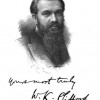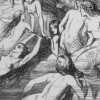
Jason Camlot, “The First Phonogramic Poem: Conceptions of Genre and Media Format, Circa 1888”
By 1888, the technology of the phonograph, and the medium of the phonograph cylinder, were established as market-ready. What was the imagined potential of this media technology in relation to known modes of communication and expression? This article recounts how “The Phonogram” or phonographic letter was prototyped from 1887 to 1892 through the efforts of Thomas Alva Edison and his London agent George Gouraud. Edison’s prototyping work and Gouraud’s efforts in developing recordings, scripts for phonogramic speeches, and formats for typographical transcription of the cylinder recordings represent a rich case study for documenting the nature and significance of their efforts to consolidate the medium and define the generic parameters of the phonogram (a speech recording) as a distinct form of global communication. By theorizing the relationship between late-Victorian concepts of medium, format and genre, respectively, and by interpreting the “first phonogramic poem” (16 June 1888) as an articulation of the meaning of sound recording at the historical moment that it arrived as a viable media technology, this article helps explain how sound recording technologies were imagined in relation to specific genres of communication. Drawing upon periodical literature, and documentation available through the Thomas Edison Papers archive—including phonogramic transcripts and speeches, marketing and foreign business strategies, patent applications, and packaging and design documents—this article explains, in particular, the generic and rhetorical protocols that informed the attempt to establish the phonogram as a new medium of intimate communication and international correspondence.

Daniel Bivona, “On W. K. Clifford and ‘The Ethics of Belief,’ 11 April 1876”
The mathematician W. K. Clifford was the youngest and possibly most controversial member of the Metaphysical Society, a group originally formed by Alfred Lord Tennyson and some close friends. Lasting from 1869 to 1880, the Society ultimately brought together a great variety of intellectuals, writers, philosophers, scientists, poets, journal editors, politicians, and Church figures of the era for vigorous debates on metaphysical topics. A pioneering promoter and translator of the non-Euclidian geometer Riemann, Clifford anticipated Einstein’s discovery that gravity was not a mysterious force of bodies but an effect of curved space, but it was his withering criticism of metaphysical claims before the Metaphysical Society – in particular, his attack on the morality of believing on insufficient evidence, an argument which was delivered two years after he first joined the group and later published as the essay “The Ethics of Belief” – that marked him as the most controversial proponent of the agnostic position in the late Victorian period. When he died at the young age of 33 in 1879, Clifford left a legacy of important unpublished scientific work and a number of impressive published essays in which he offered both a very compelling critique of the ethics of metaphysical commitments and a powerful argument, inspired by Darwin’s Descent of Man, in favor of the claim that ethics derive from evolutionary history rather than descending from an immaterial God.

John M. Picker, “Threads across the Ocean: The Transatlantic Telegraph Cable, July 1858, August 1866”
This essay considers the significance of one of the signal technological developments of the nineteenth century—an event so signal that it happened twice. The transatlantic telegraph cable linking the Old World with the New was first successfully completed in August 1858, only to cease functioning within a month, and was permanently re-established in July, 1866, this time accompanied by the reappearance, with slight variations, of much of the verse and prose written to commemorate the original success, in what might be considered a case of canny cultural recycling. While the cable ultimately connected England and the United States, it only did so by way of Ireland and Canada, which is to say that this was very much an imperial project, one celebrated as reinforcing transatlantic ethnic and linguistic superiority in a mythology of Anglo-Saxonism that Victorians largely constructed and widely endorsed. As a way to approach this convergence of ideologies of progress, empire, language, and race, the essay focuses on what arguably was the critical aspect of the cable’s material composition, and considers, in general terms and in the specific literary case of Henry James, how the concept of insulation can help us to interpret representations of the cable and the transatlantic ties it extended.
